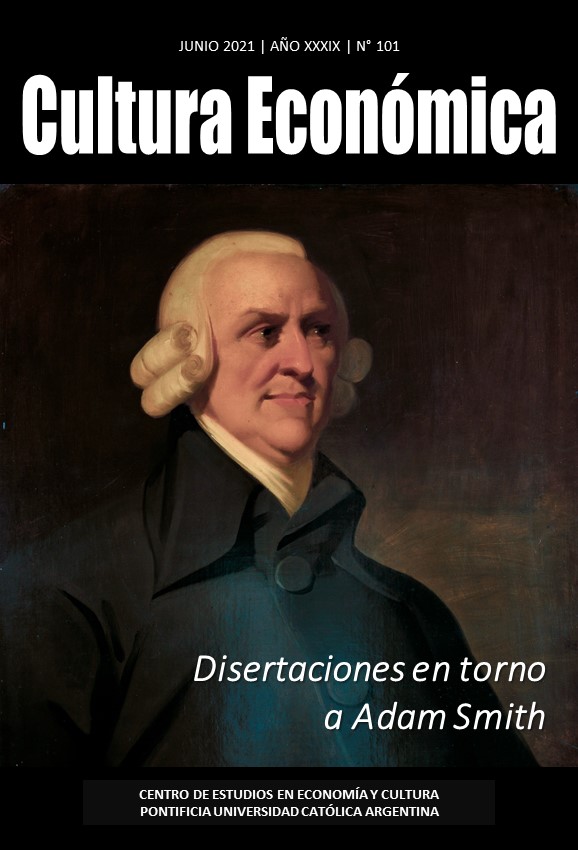The dialogic-imaginative character of creativity and innovation in Adam Smith
DOI:
https://doi.org/10.46553/cecon.39.101.2021.p32-49Keywords:
ADAM SMITH, ECONOMIC GROWTH, CREATIVITY, INNOVATION, DIVISION OF LABOUR, IMAGINATION, LANGUAGEAbstract
Adam Smith’s emphasis on the increase in productivity brought about by the division of labour in the Wealth of Nations led his general conception of the dynamics of economic growth to be associated almost exclusively with the productive specialization of labour and the free expansion of competitive markets. In this article we will try to show another perspective on Smithian economic growth. This perspective focuses on two fundamental aspects: on the one hand, the importance of imagination in creative-innovative processes, and, on the other, the dialogical basis of division of labour. In this way, we propose that an integral reading of Smith’s work is relevant, not only to reach a more complete understanding of the author’s own economic ideas, but also to provide interesting suggestions for thinking about the dynamics of growth and development today.Downloads
References
Alburquerque, F. (2013). Economía del Desarrollo y Desarrollo Territorial. Recuperado de: http://www.conectadel.org/wp-content/uploads/downloads/2015/03/E%C2%AADesarrollo-y-Desarrollo-Territorial-3.01.pdf
Andersson, Å. E. (2009). “Economics of Creativity”. En Karlsson, C. et al. (Eds.). New Directions in Regional Economic Development (pp. 79-95). Berlin: Springer.
Ballor, J. & Claar, V. (2019). “Creativity, innovation, and the historicity of entrepreneurship”. Journal of Entrepreneurship and Public Policy, 8(4), 513-522.
Carrión, G. (2016). “Estructura imaginativo-pasional de la naturaleza humana y economía en David Hume”. Filosofía de la Economía, Vol. 5, 5-26.
Carrión, G. (ed.) (2017). Escritos preliminares de la Riqueza de las Naciones y consideraciones sobre la primera formación de las lenguas. Madrid: Biblioteca Nueva.
Chesbrough, H. W. (2003). Open Innovation: The new imperative for creating and profiting from technology. Boston: Harvard Business School Press.
Chesbrough, H. W. (2020). Open Innovation Results: Going Beyond the Hype and Getting Down to Bussines. New York: Oxford University Press.
Costamagna, P. (2015). Política y formación en el desarrollo territorial. Aportes al enfoque pedagógico y a la investigación. Bilbao: Orkestra-Instituto Vasco de Competitividad.
Gutiérrez Rojas, C. & Baumert, T. (2018). “Smith, Schumpeter y el estudio de los sistemas de innovación”. Economía y Política, 5(1), 93-111.
Legros, P., Newman, A. & Proto, E. (2014). “Smithian Growth Through Creative Organization”. The Review of Economics and Statistics, 96(5), 796–811.
Loasby, B. J. (2002). “The evolution of knowledge: beyond the biological model”. Research Policy, 31(8-9), 1227–1239.
Loasby, B. J. (2014). “The Evolution of Knowledge and Knowledge of Evolution”. Jahrbücher f. Nationalökonomie u. Statistik, Vol. 234/2+3, 142-157.
Montes, L. (2019). “Adam Smith’s foundational idea of sympathetic persuasion”. Cambridge Journal of Economics, 43(1), 1-15.
Nakamura, L. (2000). “Economics and the New Economy: The Invisible Hand Meets Creative Destruction”. Business Review (Federal Reserve Bank of Philadelphia), July-August, 15-30.
Pol, E. (2013). “Reconciling the Invisible Hand and innovation”. Economics of Innovation and New Technology, 22(5), 431–446.
Rosenberg, N. (1965). “Adam Smith on the Division of Labour: Two Views or One?”. Economica, 32(126), 127-139.
Sacchetti, F., Sacchetti, S. & Sugden, R. (2009). “Creativity and socio‐economic development: space for the interests of publics”. International Review of Applied Economics, 23(6), 653-672.
Schliesser, E. (2005). “Wonder in the Face of Scientific Revolutions: Adam Smith on Newton’s ‘Proof’ of Copernicanism”. British Journal for the History of Philosophy, 13(4), 697-732.
Smith, A. (1995). Lecciones sobre jurisprudencia (Curso 1762-3). Granada: Comares.
Smith, A. (1996). Lecciones sobre jurisprudencia [Reporte de 1766]. Madrid: BOE/CEC.
Smith, A. (1998). Ensayos filosóficos. Madrid: Pirámide.
Smith, A. (1999). Investigación sobre la naturaleza y causas de la riqueza de las naciones. México: FCE.
Smith, A. (2004). Teoría de los sentimientos morales. Madrid: Alianza.
Smith, A. (2017). “Consideraciones sobre la primera formación de las lenguas y el diferente genio de las lenguas originales y compuestas”. En Carrión, G. (ed.). Escritos preliminares de la Riqueza de las naciones y consideraciones sobre la primera formación de las lenguas. Madrid: Biblioteca Nueva.
Wight, J. (2009). “Adam Smith on Instincts, Affection, and Informal Learning: Proximate Mechanisms in Multilevel Selection”. Review of Social Economy, 67(1), 95-113.
Downloads
Published
How to Cite
Issue
Section
License













